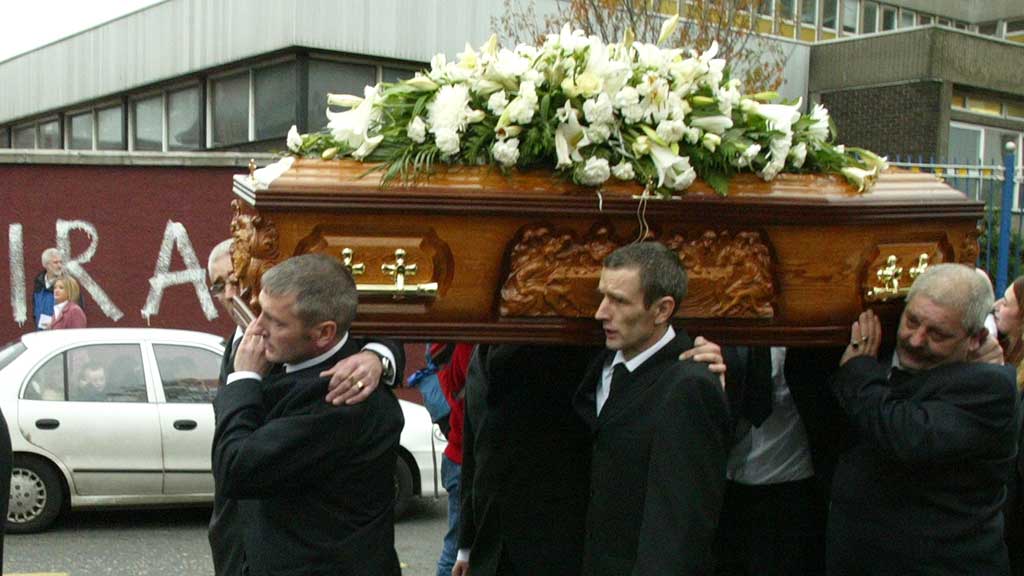Who was Jean McConville, one of N.Ireland’s ‘disappeared’?
The arrest of Gerry Adams brings the murder of Jean McConville into the spotlight over 40 years after her death. Channel 4 News looks at the killing which has cast a shadow over Sinn Fein’s leader.

Who was Jean McConville?
Jean McConville, née Murray, was born into an east Belfast protestant family in 1934. She converted to Catholicism after getting married to Arthur McConville, and they were forced to move out of the mainly protestant east of the city to mainly Catholic west.
However six weeks after settling into the Divis Flats, on the Lower Falls Road, Arthur died from cancer in 1971. The couple had 10 children, ranging from the ages of six to 15, when McConville was abducted from her home by the IRA in December 1972. Her son Michael, who was 11 at the time, recalls how between 10 and 12 IRA members – men and women – came into the family home and dragged her away in front of him, and six of his siblings. She was never seen again.
Why was she killed?
According to former IRA commander Brendan Hughes, a former friend of Gerry Adam’s, McConville was killed because she was believed to be an informer. Mr Hughes also alleged that Mr Adams had set up the hit squad and that listening devices were found in McConville’s home.
In 1972, the provisional IRA had set up a secret unit to deal with informants, after a series of leaks to the security forces. It was tasked with seeking out members of the Catholic or Republican community who had been recruited by the British army and police as informants. McConville was one of its targets, according to Mr Hughes.
McConville’s family have another take on why she was killed: they say she was seen helping an injured British soldier, and had already faced intimidation after her husband died, for being considered an outsider in the fiercely Republican Divis tower.
An investigation into her murder by the police ombudsman in 2006, found that there was no evidence to suggest she was an informer.
Why wasn’t her body found until 2003?
The IRA didn’t acknowledge responsibility for her death until 1999, when they passed on information to the police about where her body was buried. They said she had been taken across the border and buried on Sheling Hill beach in County Louth – around 50 miles from where she lived.
But even then, a huge search by Irish Gardaí led to no recovery (see above). Four years later, a passerby walking along the beach came across it and she was finally buried by her family in 2003.
Read more from Political Editor Gary Gibbon on the implications of Gerry Adams’s arrest>

Why is Gerry Adams being arrested now?
Over 40 years after her death, there have been several arrests related to McConville’s murder in the last month. In March, veteran republican Ivor Bell, 77, was charged with aiding and abetting the murder, while five others have been detained and questioned.
This police activity follows a court ruling last year that forced Boston College to hand over tapes of interviews with paramilitaries which contained information about the killing. The interviews were undertaken on the understanding that they would only be made public after the interviewees died – an agreement not recognised by law.
Former IRA commander Mr Hughes said in the tapes that Mr Adams gave the order for McConville’s body to be “disappeared”: as a widowed mother of 10, it was believed her killing would cast the IRA in a bad light, so it was preferable if the paramilitary group was not linked explicitly to the murder.
However it is believed that the interviews with Mr Hughes and Dolours Price, another former IRA paramilitary member, do not provide enough information to secure a prosecution.
Sinn Fein has a different reading of the timing of the arrest: Deputy Leader Lou McDonald said it was politically motivated, and designed to undermine the party’s growing support ahead of local and European parliament elections.

Photo: Family members of murdered Belfast mother Jean McConville pass the Divis Flats tower, west Belfast, before her funeral on 1 November, 2003.
Who are N.Ireland’s ‘disappeared’?
Jean McConville is just one of at least 15 people murdered by the IRA whose bodies were buried in secret locations – collectively named the “disappeared”. Seven bodies, including McConville’s have been found, but the remainder are still missing.
In 1999, the Independent Commission for the Location of Victims’ Remains was set up by the British and Irish governments, whereby anyone with information about the whereabouts of the secret graves could come forward without fear of prosecution.
However, because McConville’s body was found by chance, a coroner ruled at the inquest into her death that her murder would not be covered by the deal.
McConville’s name, and the impact of her disappearance on her 10 children, who were split up and put into care, only hit the headlines in 1999 after the commission was launched.
The bodies found following the commission’s investigations were: Brian McKinney, John McClory, Danny McIlhone, Charles Armstrong, Peter Wilsoon, Gerard Evans, Eugene Simons and Jean McConville.
Those still missing include Brendan McGraw, Columba McVeigh, Joe Lynskey, Kevin McKee, Seamus Wright, Seamus Ruddy and Captain Robert Nairac.